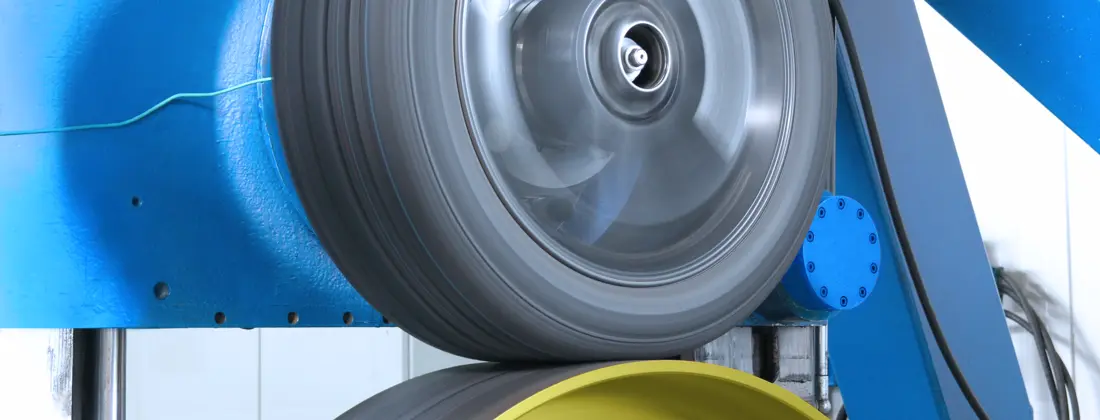ASTM F1805 Snow Traction Tyre Testing
The ASTM F1805 standard specifies the procedure for testing snow traction of tyres, providing a critical measure to evaluate tyre performance in snowy conditions. This service is essential for automotive manufacturers and tyre producers who need to ensure their products meet stringent safety standards.
Compliance with this test ensures that tyres perform reliably under winter driving conditions, which can vary significantly from region to region. The test simulates real-world driving scenarios where snow accumulation occurs on the road surface. It is a key factor in determining tyre performance and safety during cold weather conditions.
The procedure involves placing a specimen tyre onto a testing rig that replicates the forces and conditions typically encountered when a vehicle travels over snowy surfaces. The rig applies controlled loads and speeds to simulate different driving situations, including braking, cornering, and accelerating on snow-covered roads.
The test apparatus consists of a specially designed sled with a frame and wheels capable of applying the necessary forces. A load cell measures the force between the tyre and the testing surface. The sled is equipped with an electric motor to control speed and direction, ensuring precise simulation of real-world conditions.
During the test, various parameters are monitored and recorded for each trial run. These include the tyre's grip coefficient on snow, slip angle, lateral force distribution, and energy dissipation characteristics. The results help manufacturers understand how their tyres perform under specific winter driving conditions.
The acceptance criteria for this test are based on ISO 18576-3, which sets minimum performance requirements for tyres in snowy environments. Compliance with these standards ensures that the tested tyre meets or exceeds the expected safety and performance levels required by automotive manufacturers and regulatory bodies.
Testing tyre snow traction is crucial not only for ensuring passenger safety but also for enhancing overall vehicle handling and control during winter driving conditions. This service plays a pivotal role in advancing technology and improving safety features of tyres, thereby contributing significantly to the automotive industry's commitment to road safety.
Industry Applications
| Application Area | Description |
|---|---|
| Automotive Manufacturing | This service is used to evaluate tyre performance during cold weather conditions, ensuring that tyres meet safety and performance standards. |
| Tyre Production | Used for quality control and improvement of tyre design and manufacturing processes. |
| R&D Engineering | Aids in the development of new tyre technologies by providing real-world performance data under specific winter conditions. |
| Procurement | Serves as a basis for selecting suppliers who meet stringent snow traction requirements, ensuring product quality and safety. |
This ASTM F1805 tyre testing service is particularly valuable in regions where winter driving conditions are common. It ensures that tyres perform reliably under cold weather conditions, thereby enhancing overall vehicle handling and control during winter driving conditions. This service plays a pivotal role in advancing technology and improving safety features of tyres.
Quality and Reliability Assurance
The ASTM F1805 tyre snow traction test is designed to provide accurate, reliable results that are crucial for quality assurance programs. The test ensures that tyres meet the highest standards of performance in snowy conditions, which is vital for both consumer safety and regulatory compliance.
Quality managers rely on this service to verify that their products consistently meet or exceed industry benchmarks. Compliance with ASTM F1805 not only enhances brand reputation but also builds trust among consumers who value product reliability and safety.
The testing process involves multiple repetitions for each specimen tyre, ensuring consistent results across trials. The data collected during these tests is analyzed to identify any areas where improvements can be made in tyre design or manufacturing processes. This continuous improvement approach ensures that tyres are continually advancing towards higher levels of performance and reliability.
Regulatory bodies often require compliance with ASTM F1805 as part of their certification process for tyres intended for sale in regions prone to snowfall. Compliance with this standard is a key factor in ensuring that tyres meet the stringent safety standards set by these bodies, thereby protecting public safety and reducing accidents on snowy roads.
In addition to enhancing product quality and reliability, this service also supports the development of new tyre technologies. By providing real-world performance data under specific winter conditions, it helps R&D engineers refine their designs and improve manufacturing processes. This commitment to innovation ensures that tyres are continually advancing towards higher levels of performance and reliability.
Environmental and Sustainability Contributions
The ASTM F1805 tyre snow traction test contributes positively to environmental sustainability by promoting the development and use of tyres that are more efficient, durable, and environmentally friendly. By ensuring that tyres perform reliably under cold weather conditions, this service helps reduce the frequency of accidents on snowy roads, which can lead to fewer vehicle emissions.
Additionally, the test supports the use of advanced materials and manufacturing techniques that can improve tyre efficiency and durability. This not only extends the lifespan of tyres but also reduces the amount of waste generated during their lifecycle. By promoting the use of sustainable practices in tyre production, this service helps contribute to a more environmentally friendly automotive industry.
Furthermore, the test ensures that tyres are designed with safety as a priority, which can lead to fewer accidents on snowy roads and reduced need for emergency services. This contributes to a safer driving environment and reduces the overall environmental impact of vehicle use during winter months.





